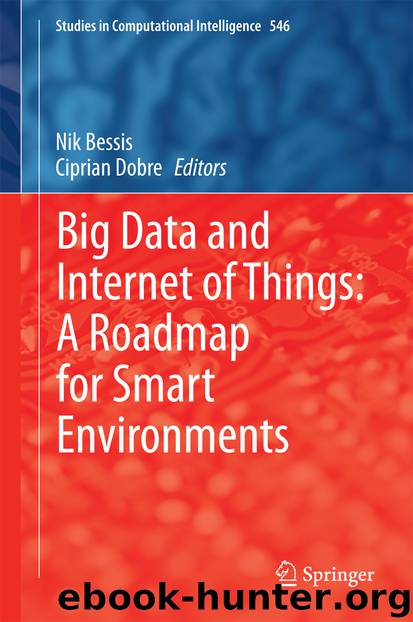Big Data and Internet of Things: A Roadmap for Smart Environments by Nik Bessis & Ciprian Dobre

Author:Nik Bessis & Ciprian Dobre
Language: eng
Format: epub
Publisher: Springer International Publishing, Cham
6 Design Decisions and Applications
We made a number of design decisions during the development of the CADDOT model. These decisions address the challenges we highlighted in earlier sections.
Security Concerns and Application Strategies: There are different ways to employ our proposed model CADDOT as well as the tool SmartLink in real world deployments. Figure 6 illustrates two different application strategies. It is important to note that neither our model nor the software tool is limited to a specific device or platform. In this paper, we conduct the experimentations on an Android-based mobile phone, as detailed in Sect. 7. In strategy (a), a Raspberry Pi (raspberrypi.org) is acting as the SmartLink tool. This strategy is mostly suitable for smart home and office environments where WiFi is available. Raspberry Pi continuously performs the discovery and configuration process, as explained in Sect. 5. Finally, Raspberry Pi provides the authentication details to the sensor which is connected to the secure home/office WiFi network. The sensor is expected to send data to the processing server (local or on cloud) directly over the secured WiFi network. In this strategy, SmartLink is in static mode. Therefore, several SmartLink installed Raspberry Pi devices may be required to cover a building. However, this strategy can handle a high level of dynamicity.
The strategy (b) is more suitable for situations where WiFi is not available or less dynamic. Smart agriculture can be considered as an example. In this scenario, sensors are deployed over a large geographical area (e.g. Phenonet [11]). Mobile robots6 (tractors or similar vehicles) with a SmartLink tool attached to them can be used to discover and configure sensors. SmartLink can then help to establish the communication between sensors and sinks. The permanent sinks used in the agricultural fields are usually low-level sinks (such as Messhablium [27]). Such sinks cannot perform sensor discovery or configuration in comparison to SmartLink. Such sinks are designed to collect data from sensors and upload to the cloud via 3G.
Many more different strategies can be built by incorporating the different characteristics pointed out in the above two strategies. This shows the extensibility of our solution. For example, Raspberry Pi, which we suggested for use as a SmartLink in strategy (a), can be replaced by corporate mobile phones. So, without bothering the owner, corporate mobile phones can silently perform the work of a SmartLink.
Fig. 6Application strategies of CADDOT model and SmartLink tool. a usage of static SmartLink b usage of mobile SmartLink
Download
This site does not store any files on its server. We only index and link to content provided by other sites. Please contact the content providers to delete copyright contents if any and email us, we'll remove relevant links or contents immediately.
Algorithms of the Intelligent Web by Haralambos Marmanis;Dmitry Babenko(8522)
Test-Driven Development with Java by Alan Mellor(7406)
Data Augmentation with Python by Duc Haba(7299)
Principles of Data Fabric by Sonia Mezzetta(7048)
Learn Blender Simulations the Right Way by Stephen Pearson(6984)
Microservices with Spring Boot 3 and Spring Cloud by Magnus Larsson(6805)
RPA Solution Architect's Handbook by Sachin Sahgal(6216)
Hadoop in Practice by Alex Holmes(6031)
The Infinite Retina by Robert Scoble Irena Cronin(5917)
Jquery UI in Action : Master the concepts Of Jquery UI: A Step By Step Approach by ANMOL GOYAL(5873)
Big Data Analysis with Python by Ivan Marin(5721)
Life 3.0: Being Human in the Age of Artificial Intelligence by Tegmark Max(5402)
Pretrain Vision and Large Language Models in Python by Emily Webber(4684)
Infrastructure as Code for Beginners by Russ McKendrick(4463)
WordPress Plugin Development Cookbook by Yannick Lefebvre(4195)
Functional Programming in JavaScript by Mantyla Dan(4124)
The Age of Surveillance Capitalism by Shoshana Zuboff(4116)
Embracing Microservices Design by Ovais Mehboob Ahmed Khan Nabil Siddiqui and Timothy Oleson(3981)
Applied Machine Learning for Healthcare and Life Sciences Using AWS by Ujjwal Ratan(3959)
